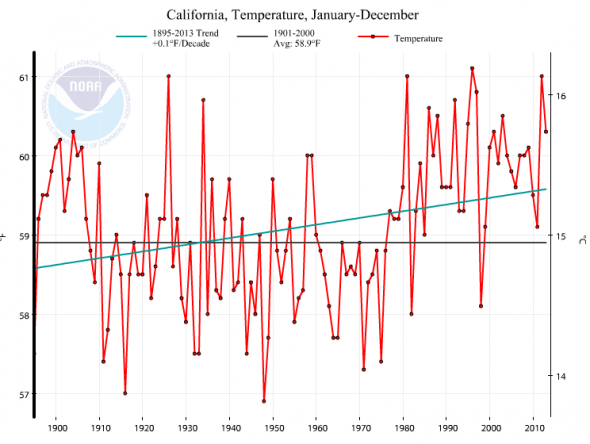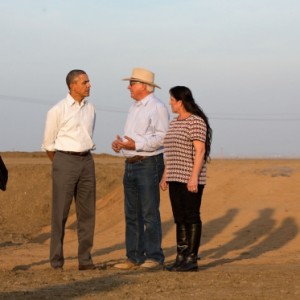Peter Gleick: Clarifying the Discussion about California Drought and Climate Change
In the last few months, as the severe California drought has garnered attention among scientists, policymakers, and media, there has been a growing debate about the links between the drought and climate change. The debate has been marked by considerable controversy, confusion, and opaqueness.
The confusion stems from the failure of some scientists, bloggers, reporters, and others to distinguish among three separate questions. All three questions are scientifically interesting. But the three are different in their nuance, their importance to policy, and their interest to politicians and water managers. Here are the three different questions:
1. Is the California drought caused by climate change?
2. Is the California drought, no matter the cause, influenced or affected by climate changes already occurring?
3. How will climate changes affect future drought risks in California?
These questions are not the same thing. Yet repeatedly, some have asked one question when they thought they were asking a different one. Some have been asked one question and intentionally or accidentally answered a different one. Some have confused an answer to one question as an answer to a different question.
Frankly, the entire discussion has been frustrating for all involved. For the sake of clarity in the future, people involved in this discussion should be clear whether they are asking or answering question #1, #2, or #3, or even another question entirely. In addition, the answers for California may be different than other regions of the U.S. or world.
And to prime the pump, so to speak, here are my thoughts about the answers, with some relevant recent scientific papers listed at the end.
1. Is the California drought caused by climate change? The “causality” question is a bad question to ask and I wish journalists would stop asking it, but without a doubt it is the most common one I receive. From a scientific perspective, the influence of climate change on current extreme events is a very exciting research topic and there is evidence linking climate change with some specific recent extremes. Nevertheless, I think the current scientific answer to this question for the California drought is neither “yes” nor “no.” We do not know. The current drought, measured by hydrologic variables of precipitation amount, form, location, and timing, is certainly severe, but it does not appear to be statistically significantly different from past droughts in the instrumental or longer-term paleoclimatic record. But here is another key point lost to many. Just because the answer is not “yes” does NOT mean the answer is “no.” Get it? This subtle difference is often lost: when a scientist says the current drought doesn’t look much different from some past extreme droughts, this says nothing about causality of the current drought.
2. Is the California drought, no matter the cause, being influenced or affected by climate changes already occurring? This question is much more interesting than the first one about causality. And I think the answer to this is unambiguously “yes,” but we do not know the net/overall influence of current climate changes. We know that climate is changing and that climate changes influence weather. That “influence” can take many forms: changes in storm patterns, precipitation frequency or intensity, the form of precipitation, and so on. And we know that there are many uncertainties about the nature and extent of these changes. But I say the answer to this specific question is “yes” for one simple reason: current average temperatures in California, like average temperatures worldwide, are higher today than they were in the past century because of human-caused climate change (See Figure 1). These higher temperatures worsen the drought through extra soil moisture loss, altered timing of snowmelt, and decreased reservoir levels from extra evaporation. As a new paper in Nature Climate Change states: “Climate change is adding heat to the climate system and on land much of that heat goes into drying.”[1] It is also possible that climate change has influenced other factors, such as the precipitation regime (with more or less precipitation), but the signal of this influence is still buried in the noise. So I’m not saying the net influence of climate change on the current California drought is unambiguously for the worse or better, just that the influence is real, and the most definitive and well-understood effect (higher temperatures) has decreased current water availability.
Annual temperature trends in California over the past 118 years. (Source: NOAA, 2014)
The increasing trend in annual temperature in California over the past 118 years. (Source: NOAA, 2014). This trend mirrors the global increase.
The increasing trend in annual temperature in California over the past 118 years. (Source: NOAA, 2014). This trend mirrors the global increase.
3. How will climate changes affect future drought risks in California? There are two answers to this: the first is that climate changes will almost certainly affect California drought risks; but the second is that these effects will be diverse, complicated, and interconnected, and many remain uncertain and exciting topics for current research. Hundreds of research papers have been written about the vulnerability of California water – both the natural hydrology and the complex infrastructure built to manage that hydrology – to climate changes. For the purposes of the current debate around the drought, the question seems to focus on whether future California droughts will be more or less frequent, and more or less severe. There are many factors that go into assessing this question. The scientific literature has an extensive discussion of all of these factors, some of which have been successfully resolved; others remain highly uncertain. For example, we know with a high degree of certainty that temperatures are going to continue to go up and increase evaporative demands for water. We know with a high degree of certainty that the ratio of rain to snow falling in the mountains will rise, snowpack will diminish, and that the timing of runoff will change. We know with a high degree of certainty that sea-level is rising, with effects on coastal aquifers and brackish water ecosystems. As the Trenberth et al. paper mentioned above notes: “Climate change is adding heat to the climate system and on land much of that heat goes into drying. A natural drought should therefore set in quicker, become more intense, and may last longer. Droughts may be more extensive as a result. Indeed, human-induced warming effects accumulate on land during periods of drought because the ‘air conditioning effects’ of water are absent. Climate change may not manufacture droughts, but it could exacerbate them and it will probably expand their domain in the subtropical dry zone.”
But California droughts are also fundamentally linked to the quantities and timing of precipitation, the dynamics of storm formation in the Pacific Ocean, the impacts of climate change on the frequency and intensity of El Niño and La Niña events and the Pacific Decadal Oscillation, and the behavior of the jet stream as conditions in the Arctic change. These changes are less certain, vitally important to the frequency and intensity of future California drought impacts, and remain serious topics for research and analysis. And as some observers have noted, the risk that future droughts will worsen is more certain for other regions of the world.
The research and the debate over climate change and California droughts will continue. But before commenting, let’s make sure we understand what question is actually being asked, what question should be asked, and what question is actually being answered.
Background
Cayan et al., 2010. “Future dryness in the southwest US and the hydrology of the early 21st century drought, PNAS, Vol. 107, December 14, 2010, pp 21271-21276:
Although the recent drought may have significant contributions from natural variability, it is notable that hydrological changes in the region over the last 50 years cannot be fully explained by natural variability, and instead show the signature of anthropogenic climate change.
Dai, A. 2013. “Increasing drought under global warming in observations and models,” Nature Climate Change, Vol 3., pp. 52-58. DOI:10.1038/nclimate1633
Trenberth, K. E., A. Dai, G. van der Schrier, P. D. Jones, J. Barichivich, K. R. Briffa, and J. Sheffield, 2014: Global warming and changes in drought. Nature Climate Change, 4, 17-22, doi:10.1038/NCLIMATE2067.
Wehner et al., 2011. “Projections of future drought in the continental United States and Mexico,” Journal of Hydrometeorology, Vol. 12, December 2011, pp 1359-1377.
All models, regardless of their ability to simulate the base-period drought statistics, project significant future increases in drought frequency, severity, and extent over the course of the 21st century under the SRES A1B emissions scenario.
Pederson et al., 2011. “The unusual nature of recent snowpack declines in the NorthAmerican Cordillera,” Science, Vol. 333, 15 July 2011, pp 332-335.
Over the past millennium, late 20th century snowpack reductions are almost unprecedented in magnitude across the northern Rocky Mountains and in their north-south synchrony across the cordillera. Both the snowpack declines and their synchrony result from unparalleled springtime warming that is due to positive reinforcement of the anthropogenic warming by decadal variability. The increasing role of warming on large-scale snowpack variability and trends foreshadows fundamental impacts on streamflow and water supplies across the western United States.
See also the conclusions from:
The 2013 report of the IPCC’s Working Group I, The Science Basis (pdf)
The Technical Summary from IPCC WGI 2013 report (pdf)
[1] Trenberth, K. E., A. Dai, G. van der Schrier, P. D. Jones, J. Barichivich, K. R. Briffa, and J. Sheffield, 2014: Global warming and changes in drought. Nature Climate Change, 4, 17-22, doi:10.1038/NCLIMATE2067.









Leave a Reply
Want to join the discussion?Feel free to contribute!